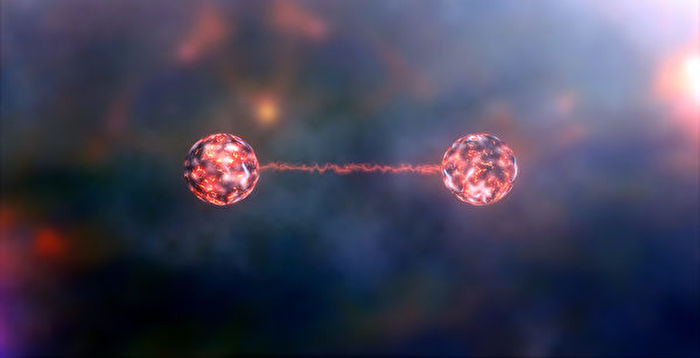[The Epoch Times, October 24, 2022](The Epoch Times reporter Linda compiled and reported) What physicist Einstein called “spooky action at a distance”, that is, two particles far apart can produce instantaneous interaction effect, is what makes quantum physics so weird and counterintuitive.
On the morning of October 4, the Royal Swedish Academy of Sciences awarded the 2022 Nobel Prize in Physics to three quantum physicists – Alain Aspect and John F. Crowe. John F. Clauser and Anton Zeilinger — whose research confirms this bizarre phenomenon and places it at the heart of the technological revolution.
The Nobel Committee said in a statement on its website that the 2022 Nobel Prize in Physics was jointly awarded to the three men for their respective outstanding work, “The optical quantum entanglement experiment establishes a violation of Bell’s inequality. , and pioneered quantum information science”.
Ulf Danielsson, secretary of the Nobel Committee for Physics, told Popular Mechanics: “One of the most fascinating predictions of quantum mechanics is that quantum entanglement can create many A single particle behaves like a whole.” The three laureates’ seminal experiments show that this incredible phenomenon persists at macroscopic distances, proving the flaws of human intuition. “
Danielsson, a professor of theoretical physics at Uppsala University in Sweden, points out that this phenomenon of instantaneous quantum connections between particles across distances is unexplained in classical physics.
He added that the research results of the three laureates are not only important for understanding the world, but also point to future applications, such as using quantum cryptography for secure communications, and building powerful quantum computers.
Prove Einstein wrong
In quantum physics, quantum entanglement describes a state in which when an experimenter measures a physical variable in one of two particles, the other particle responds instantaneously. This sounds plausible at first glance, but it becomes incomprehensible given that even if these two entangled particles are located at opposite ends of the universe, this momentary change can occur.
Quantum entanglement, as first proposed in the 1930s, violates the concept of “local realism” and can be boiled down to two claims. First, all particles have well-established properties for various experimental measurements; second, it is impossible for particles to communicate faster than the speed of light.
The instantaneous effects of entanglement challenge at least one, or even both, of the two premises. For Einstein, by challenging locality, this instantaneous variable challenged one of the key principles of his special theory of relativity (ie: nothing travels faster than the speed of light).
Einstein argued that quantum entanglement and its “spooky effects at a distance” did not violate the principle of locality; rather, it showed that quantum physics itself is incomplete. He believed that the “factor” that instantaneously connected some measurable variable of one particle to another would eventually be found. What he and other physicists thought were such as-yet-undiscovered “factors” came to be known as “local hidden variables.”
The three winners were awarded for conclusively proving that “local hidden variables” do not exist. The reason why nonlocality does not violate relativity, however, is unclear and has been hotly debated ever since. One suggestion is that the entangled particles are still part of the same system, so the distance between them doesn’t matter. However, this sounds more like a philosophical discussion.
Confirm that quantum physics is complete
In 1964, the Northern Irish physicist John Stewart Bell devised Bell’s theorem, showing that locality is a testable hypothesis. Breaking the principle of locality is called “violating Bell’s inequality”.
American theoretical and experimental physicist Clause and UC graduate student Stuart Freedman designed the first experiment in 1972 to look for such irregularities. The pair did an experiment that sent two entangled photons in opposite directions to two stationary polarizing filters.
These filters either block the photon or, depending on the photon’s angle and polarization, let it pass and reach the detector, making it reflect the state of the particle entangled with its pair. The obtained result proves that there are no hidden variables, and is therefore consistent with quantum theory. In other words, the experiment violated Bell’s inequality.
From then on, researchers were free to speculate on what applications could be made with the nonlocal nature of quantum mechanics. This led to the development of quantum cryptography and more generally quantum technologies.
Nicolas Brunner is an associate professor at the University of Geneva whose research areas are fundamental quantum theory and quantum information processing. This means that his research relies strongly on the concepts of quantum entanglement and nonlocality.
“You can use the entanglement of photons to create an encrypted system where distant parties can exchange secret messages with complete privacy,” he said. “The laws of quantum mechanics guarantee privacy and security.”
As for the significance of this award to the field of quantum physics and quantum information, Bruner thinks it is very important. “I’ve been working on quantum nonlocality for 20 years since I started my Ph.D. It’s really remarkable that it’s now being so recognised by the most important physics prize. It’s really a great introduction to the field of quantum information in general. Recognition of importance.” ◇
Editor:
